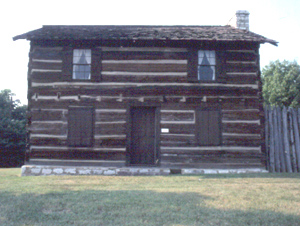
Fort James White
Fort James White, or James White Fort, was established in 1786 and became the nucleus of modern-day Knoxville. General James White (1747-1821) traveled to the wilderness of East Tennessee from Iredell County, North Carolina, in 1785, settling with his wife Mary Lawson and five children on a one-thousand-acre tract near the junction of the French Broad and Holston Rivers. To the west of First Creek he built the first residence within what is today downtown Knoxville. The house was a one-and-a-half story “saddlebag” structure built of hand-hewn square logs with clay chinking. White also built three smaller houses of log construction and arranged them to form the four corners of a quadrangle with his principal residence located in the southwest corner. He then enclosed the sides of the quadrangle with an eight-foot-high wooden palisade and oriented the main gate to face First Creek.
In 1791 White’s Fort was the site of the signing of the Treaty of Holston between Cherokee leaders and William Blount, governor of the Territory South of the River Ohio. Blount selected White’s Fort as the capital of the Southwest Territory and renamed it Knoxville. White hired Charles McClung to survey and divide a portion of his one thousand acres into sixty-four half-acre town lots. Reserving lots for himself, a church (now First Presbyterian Church, where White is buried), and for the formation of Blount College, he offered the remaining lots for sale by lottery at eight dollars each.
The White family established a second farm away from the fort, and the principal house was later incorporated as an ell into the brick residence of James Kennedy Jr. By 1906 commercial growth made demolition of the house eminent and the Kennedy estate offered it to the Knoxville Historical Society. The society did not have a site on which it could relocate the house, though, and refused the offer. Isaiah Ford, a local citizen, purchased White’s house with the intent of preserving it. He carefully marked each log, dismantled the house, and reconstructed it on Woodlawn Pike in Knoxville.
In 1959 the City Association of Women’s Clubs (CAWC) began its campaign for the reconstruction of the entire fort with the preservation and relocation of the principal house as its focal point. The CAWC established the James White Fort Association (JWFA) as a nonprofit organization to oversee the reconstruction. As the original site of the fort was already long-occupied, the JWFA selected a one-acre site nearby on Hill Avenue. However, it was not until three years later that Representative Howard Baker Sr., and Senator Estes Kefauver facilitated the passing of legislation that allowed the Knoxville Housing Authority to sell the proposed site to the JWFA for one dollar. The original James White house was again dismantled and relocated. With the construction of the palisades and other houses completed, the fort was opened to the public in 1973.
As it does not sit on its original site, the James White Fort does not qualify for historic status or local government funding. However, by 1990 White’s Fort was the most frequently visited historic site in Knoxville, providing a physical link to the past through its significance as the first settlement in Knoxville and the home of the city’s founder.



